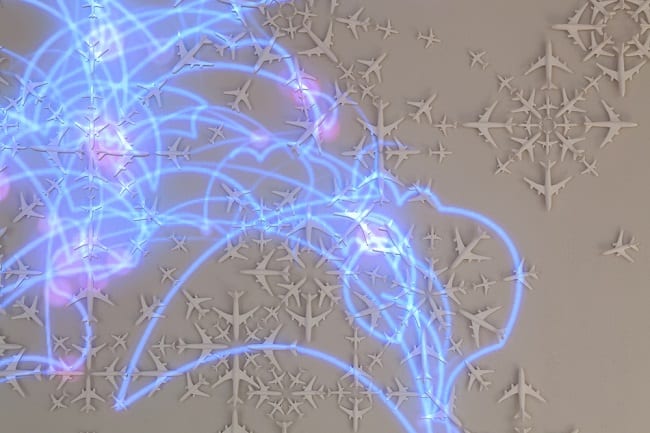A video of Saccadic Domestic Conglomerations, at Arvada Art Center, Arvada, Colorado. Collaboration between Dylan J. Beck, Adam Hinterlang and Dr. Melissa Beck.Video courtesy of the artist.
Artist Dylan J. Beck wrote CFile recently to discuss two of his exhibitions that use technology and ceramics to get viewers thinking about the role air travel plays in our lives. Here, he discusses his exhibitions Flyover Country at the Leedy-Voulkos Art Center in Kansas City and Saccadic Domestic Conglomerations, a collaborative project at the Arvada Center for the Arts in Arvada, Colorado. Below is the artist in his own words:
Each project addresses the immense amount of air travel in our contemporary world and the potential effects of this major mode of transportation that go largely unnoticed. I am exploring these ideas through ceramic and mixed media sculpture, digital imagery, and animation.
In our ever-growing and strangely-shrinking contemporary world it has become commonplace to travel great distances in a matter of hours. What has made this shrinking of the globe possible is air travel. In the United States alone there are nearly 28,000 commercial flights per day! Consequently, at any given moment there is an overwhelming number of airplanes, full of people, in the skies above our heads. Air travel is a major contributor to global carbon emissions and land use (airports). Though there are tens of thousands of commercial flights in the United States daily and airports consume large amounts of land, much of this takes place out of sight of our daily life. Through my work, I hope to start a conversation about the aforementioned issues.
My approach to installing Flyover Country (July 5 – August 31, 2013) was influenced by my sensitivity to the often-overlooked elements of landscape, architecture, and built space.
That solo exhibition at the Leedy-Volkous Art Center in Kansas City was a good example of my site-specific practice. As with many of my works, it was important to me that the work in the exhibition not only reflect upon the gallery space but on the greater geographical location, the Kansas City area and the Midwest. While living in Manhattan, Kansas, I noticed that the phrase “Flyover Country” was not merely a slight on the sparsely-inhabited and geographically-subtle middle of America, it was actually flyover country! At any given moment there were numerous airplanes in the sky above and often on clear days the only clouds were man-made contrails. This observation interlaced with the immense thunderstorms of the plains inspired me to make work about the most dynamic element of the Kansas landscape, the sky. In addition, a hot topic in the news was the redesign of the Kansas City International Airport, a redesign that was meant to reduce operation costs but would eliminate one of the country’s most passenger-friendly airports.
Once I had the larger concept of the site-specific work, I was ready to think about the actual space where the work would be installed, the Front Gallery of the Leedy-Voulkos Art Center. I visited the gallery during and between exhibitions; I took note of the space’s idiosyncrasies. The 1,830 sq ft gallery had many unique elements to consider. Being one of many galleries in the art center there were multiple entrances. There was a row of five large columns running down the center of the gallery. And entering the gallery from the street, patrons must ascend a set of stairs, slowly revealing the exhibition from ground level up. I felt that all of these elements were important to consider.
To plan and layout the exhibition I created a to-scale model in the 3D modeling program SketchUp Pro. This allowed me to not only virtually arrange pieces in the space but also to actually create hypothetical works for the space. One such piece is Control Tower, which is built onto the center column, utilizing the existing architecture to finish the piece. Another site-specific aspect of Flyover Country is AirFest!. This is a banner that is designed to fit across the entrance of the gallery, from wall to column, but it has been ripped down or has fallen. There are discarded plastic cups and used tickets strewn about the floor to invoke a sense of missing out on something. The party is over.
Many of my works are sculptural installations. This means that they are not installations where I am dramatically changing a space but the work has some assembly required. My works highlight the peculiarities of landscape, architecture, and built space as well as the peculiarities of the space in which the work resides.
The piece Saccadic Domestic Conglomerations is a three-person collaboration utilizing research data, digital animation, and industrial production methods. The digital animation, created in collaboration with artist Adam Hinterlang, is derived from saccades, or eye movements, collected by LSU psychology professor, Melissa Beck. Subjects viewed an image of Domestic Conglomerations while wearing an eye tracking device. The data collected was then translated into an animation that suggests actual flight patterns. The arrangement of the airplanes is directly related to the geographical location of major airports in the United States.
With this piece I am investigating flight patterns and densities and our relationship to this integral part of our transportation infrastructure and economy. How has this shrinking of the world changed our perception and understanding of it?
Dylan J. Beck is an MFA graduate of the Tyler School of Art, Temple University, Philadelphia.
Above image: Dylan J. Beck, Saccadic Domestic Conglomerations, at Arvada Art Center, Arvada, Colorado. Collaboration with Adam Hinterlang and Dr. Melissa Beck.
Any thoughts about this post? Share yours in the comment box below.






Dylan J. Beck, Saccadic Domestic Conglomerations, at Arvada Art Center, Arvada, Colorado. Collaboration with Adam Hinterlang and Dr. Melissa Beck.







Dylan J. Beck, Flyover Country, at the Leedy-Voulkos Art Center, Kansas City.
Visit the Leedy-Voulkos Art Center, Kansas City

Nice work, nice space.